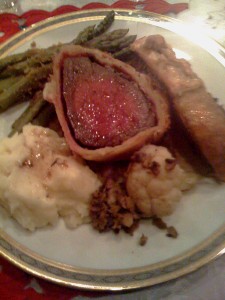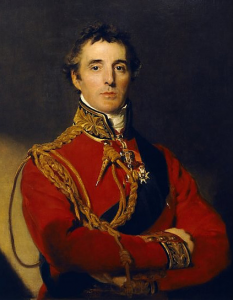 The holiday season was made for re-connecting with the family and engorging on great food. I am lucky to have a mother who is a fabulous cook and upon the occasion of holiday, I get to sit back and experience great culinary events. Thanksgiving is as traditional as they come in food selection, celebrating the seasonal turn and culmination of the harvest, but my mother is not limited to the traditional. For this Thanksgiving, the fare of celebration was not fowl nor ham, but rather – Beef Wellington. Definitely a menu item ‘against the grain’. Regardless, the dish is certainly celebratory, and has a celebratory origin. Beef Wellington, a filet of beef braised with a pate’ of mushrooms and meat, and encased in pastry, bespeaks a richness in both taste and history. The creation has been linked to Arthur Wellesley, 1st Duke of Wellington, and indirectly savors the victory of the defender of anglo-saxon civilization against the monolithic and aggressive French dictator Napoleon. In fitting fashion for reflecting such a place in history, it just happens to be delicious as well.
The holiday season was made for re-connecting with the family and engorging on great food. I am lucky to have a mother who is a fabulous cook and upon the occasion of holiday, I get to sit back and experience great culinary events. Thanksgiving is as traditional as they come in food selection, celebrating the seasonal turn and culmination of the harvest, but my mother is not limited to the traditional. For this Thanksgiving, the fare of celebration was not fowl nor ham, but rather – Beef Wellington. Definitely a menu item ‘against the grain’. Regardless, the dish is certainly celebratory, and has a celebratory origin. Beef Wellington, a filet of beef braised with a pate’ of mushrooms and meat, and encased in pastry, bespeaks a richness in both taste and history. The creation has been linked to Arthur Wellesley, 1st Duke of Wellington, and indirectly savors the victory of the defender of anglo-saxon civilization against the monolithic and aggressive French dictator Napoleon. In fitting fashion for reflecting such a place in history, it just happens to be delicious as well.
Our erstwhile hero the Duke of Wellington may have had, in actuality, nothing to do with the dish attributed to him. Most culinary experts tie the origin to permutations of the french filet de boeuf en crote’, with the connection to Wellington his love of Madeira wine, beef, and truffles. The more romantic connection is the heroic nature of the meal and the namesake. Achieving the synthesis of a perfectly temperatured filet, maintaining its succulence, and preventing the pastry from turning into a soggy mess is no mean feat. These are cooking logistics that would make a genius logistician like Arthur Wellesley quite proud. Crowned with fresh asparagus spears tendered in chicken stock, cauliflower, and mashed potatoes, the centerpiece becomes elevated to a delicious, rather elegant plane.
The great man befitting such a dish was born in Ireland in 1769 to noble birth, but it was not until he entered the army that a hint of the man that was to come made an appearance. He entered at the lowly station of ensign, but his connections lead to rapid advancement, when it became apparent that a once drifting youth proved to be premier leader of men. Wellesley found his footing in the battles the British Empire fought in subduing the subcontinent of India, specifically in the actions against the Sultan of Mysore, Tipu Sultan. The young soldier led men to victories in the battles of Mallavelly and Seringapatam against the Sultan that secured British influence over the southern Indian land mass. He continued his success in further campaigns against the powerful and larger Maratha Empire highlighted by the violent battle of Assaye, in which his personal bravery, coolness under fire, and willingness to be in the midst of battle endeared him to his troops. His rank swelled with the victories and he achieved the rank of general by the time he left India in 1804. 
He returned to Britain to enter politics, but the threat to the realm presented by the brilliant French general Bonaparte through his military domination of the continent would dominate the next decade of his life. The land mass of Europe was Napoleon’s running experiment in new battle tactics in massed forces, logistics, use of cavalry and artillery. Wellesley’s specific personality trait of patient battle development and assurance of favorable conditions made him a worthy opponent, and progressively, a threat to Napoleon’s dream of world dominance. Wellesley’s reputation was assured in his contribution to the destruction of the French flank in the Peninsula Wars for Spain and Portugal, and helped lead to Napolean’s first abdication and eventual confinement on Elba in 1813. The battle of Salamanca, freeing Madrid from French forces, and subsequently the crushing of the residual French redoubts at Vitoria, resulted in the retreat of the French army led by Field Marshal Soult and the elevation of Wellesley to Field Marshal status himself, and appointment by the King as 1st Duke of Wellington.
The momentous escape by Napoleon from Elba and the rapid return to power had all Europe shuddering. An allied force of northern Europeans and British was rapidly assembled, and Napoleon saw the need to sweep out of France into Belgium to destroy the alliance and return France to its dominant position. The battle was met in the town of Ligny, and a momentary victory was achieved by Napoleon against the Prussian forces led by General Blucher, resulting in the retreat of the allied armies to a ridge just outside the town of Waterloo. On June 18th, 1815, Napoleon set forth to destroy the Prussians and then the British sequentially. The titanic battle fought among several hundred thousand troops has become known as one of the pivotal battles in history. The many layered strategy of Napoleon this time found his equal in craft and strategy in Wellington. the typical French maneuver of overwhelming directed force this time ran into Wellington’s willingness to hold, draw in, and ambush. The chaos of battle, so often in the favor of the superbly trained and experienced French troops, proved all consuming and brought to bear Wellington’s carefully manged reserves and counter thrusts. The result was a crushing French defeat, and Napoleon’s final abdication four days later.
The battle for Waterloo against one of history’s greatest military tacticians brought Wellington the status of international hero, a label he would wear through the rest of his 83 years. It served him through a brief interlude as Prime Minister of England, and as Commander in Chief of the Forces for the rest of his life.
The occasion of his state funeral in 1852 was a level of non- royal adoration that would be known only to Lord Nelson and Winston Churchill. The 1st Duke of Wellington secured his position in history as the stone that broke the sword of Napoleon, and as such is worthy of the greatness of the culinary preparation perhaps inappropriately named for him. it is apropo that the selected dessert to climax such a magnificient meal is the multi-layered creme filled cake, the mille-feuille, otherwise known as – the Napoleon.